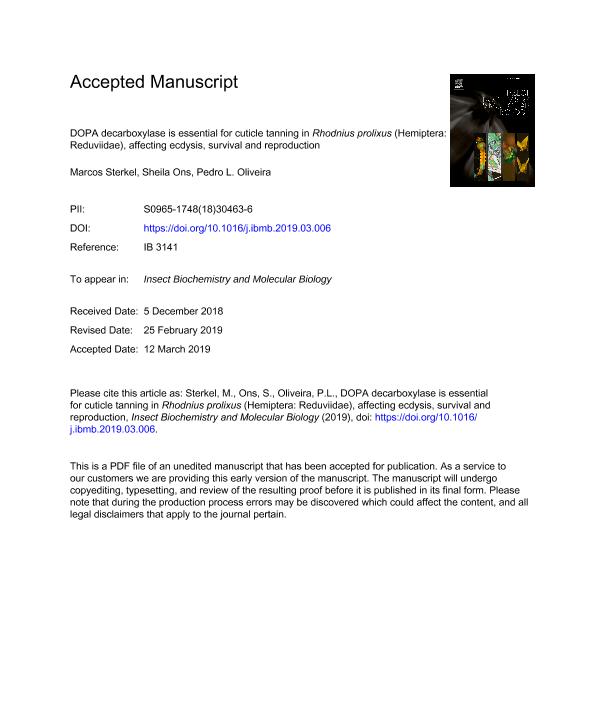Artículo
DOPA decarboxylase is essential for cuticle tanning in Rhodnius prolixus (Hemiptera: Reduviidae), affecting ecdysis, survival and reproduction
Fecha de publicación:
05/2019
Editorial:
Elsevier
Revista:
Insect Biochem. Molec. Biol.
ISSN:
0965-1748
Idioma:
Inglés
Tipo de recurso:
Artículo publicado
Clasificación temática:
Resumen
Cuticle tanning occurs in insects immediately after hatching or molting. During this process, the cuticle becomes dark and rigid due to melanin deposition and protein crosslinking. In insects, different from mammals, melanin is synthesized mainly from dopamine, which is produced from DOPA by the enzyme DOPA decarboxylase. In this work, we report that the silencing of the RpAadc-2 gene, which encodes the putative Rhodnius prolixus DOPA decarboxylase enzyme, resulted in a reduction in nymph survival, with a high percentage of treated insects dying during the ecdysis process or in the expected ecdysis period. Those treated insects that could complete ecdysis presented a decrease in cuticle pigmentation and hardness after molting. In adult females, the knockdown of AADC-2 resulted in a reduction in the hatching of eggs; the nymphs that managed to hatch failed to tan the cuticle and were unable to feed. Despite the failure in cuticle tanning, knockdown of the AADC-2 did not increase the susceptibility to topically applied deltamethrin, a pyrethroid insecticide. Additionally, our results showed that the melanin synthesis pathway did not play a major role in the detoxification of the excess (potentially toxic) tyrosine from the diet, an essential trait for hematophagous arthropod survival after a blood meal.
Archivos asociados
Licencia
Identificadores
Colecciones
Articulos(CCT - LA PLATA)
Articulos de CTRO.CIENTIFICO TECNOL.CONICET - LA PLATA
Articulos de CTRO.CIENTIFICO TECNOL.CONICET - LA PLATA
Citación
Sterkel, Marcos; Ons, Sheila; Oliveira, Pedro L.; DOPA decarboxylase is essential for cuticle tanning in Rhodnius prolixus (Hemiptera: Reduviidae), affecting ecdysis, survival and reproduction; Elsevier; Insect Biochem. Molec. Biol.; 108; 5-2019; 24-31
Compartir
Altmétricas




